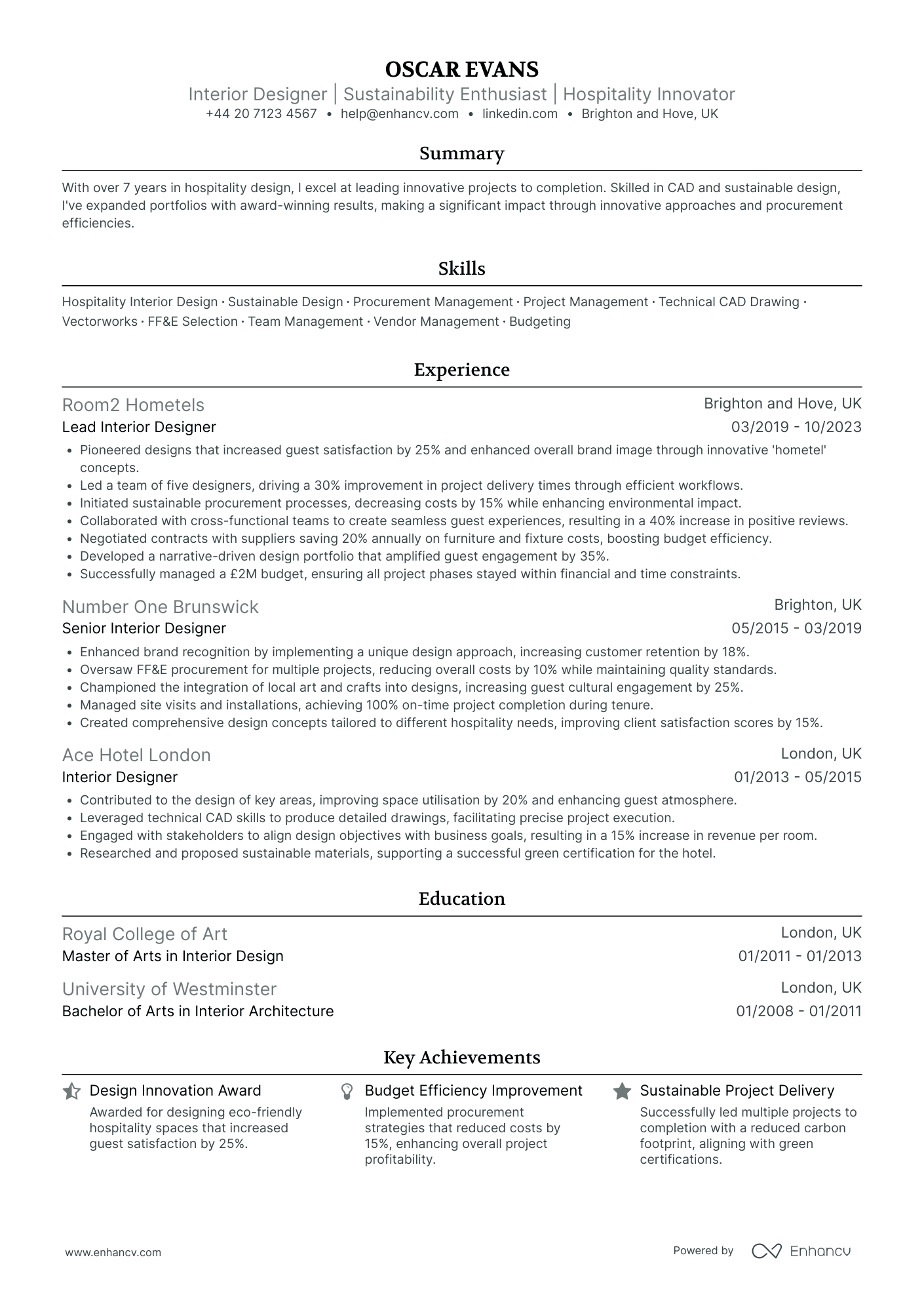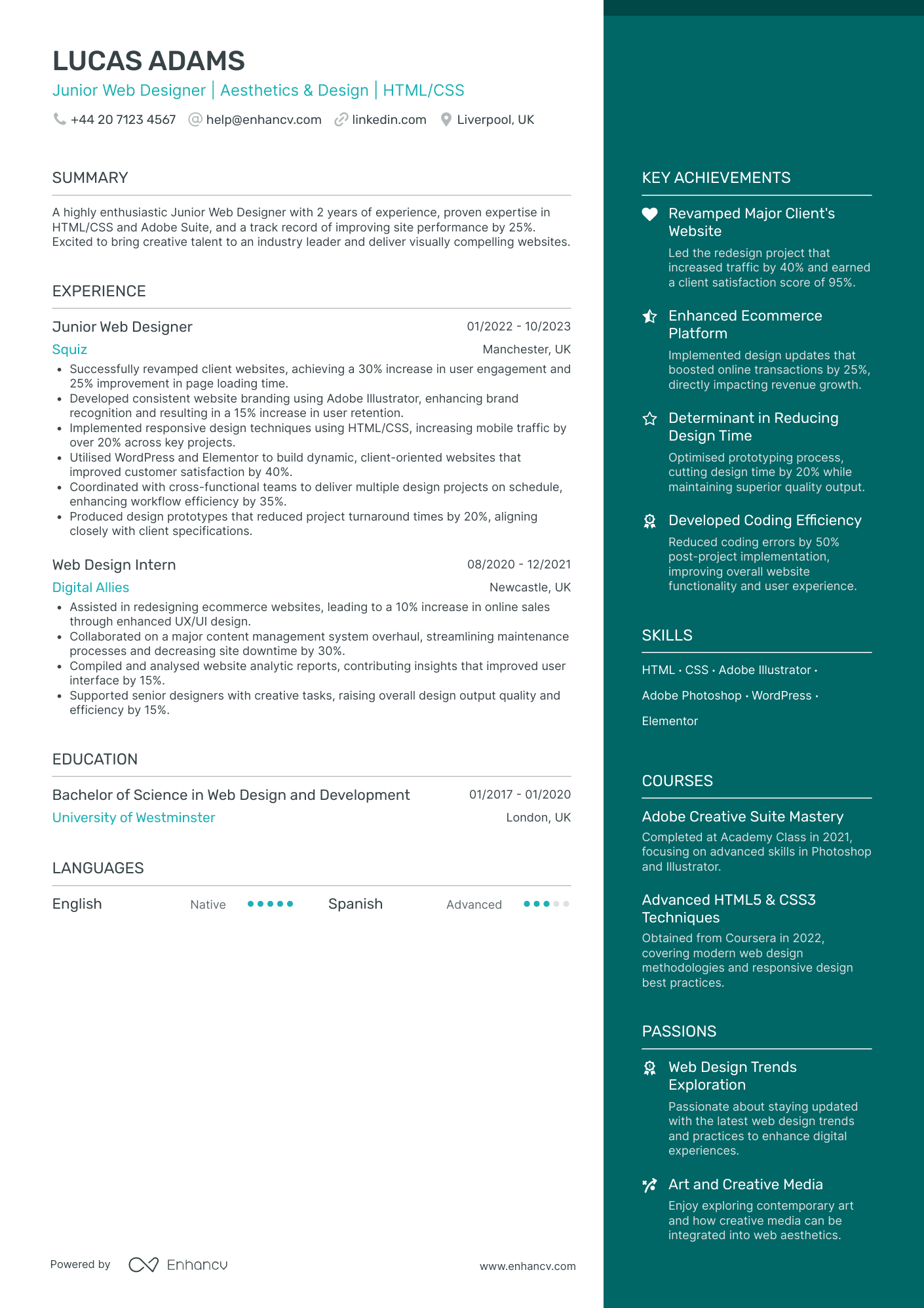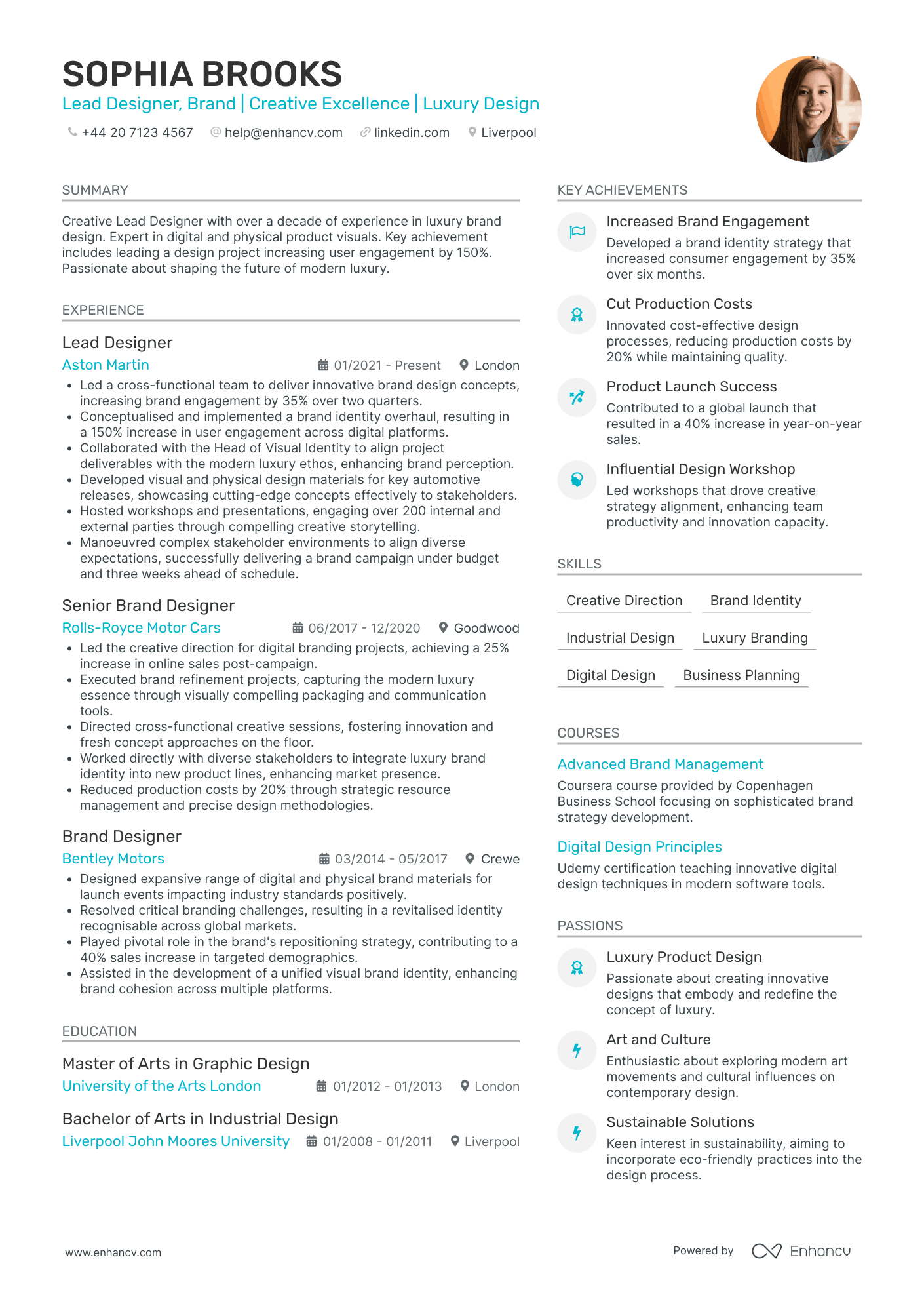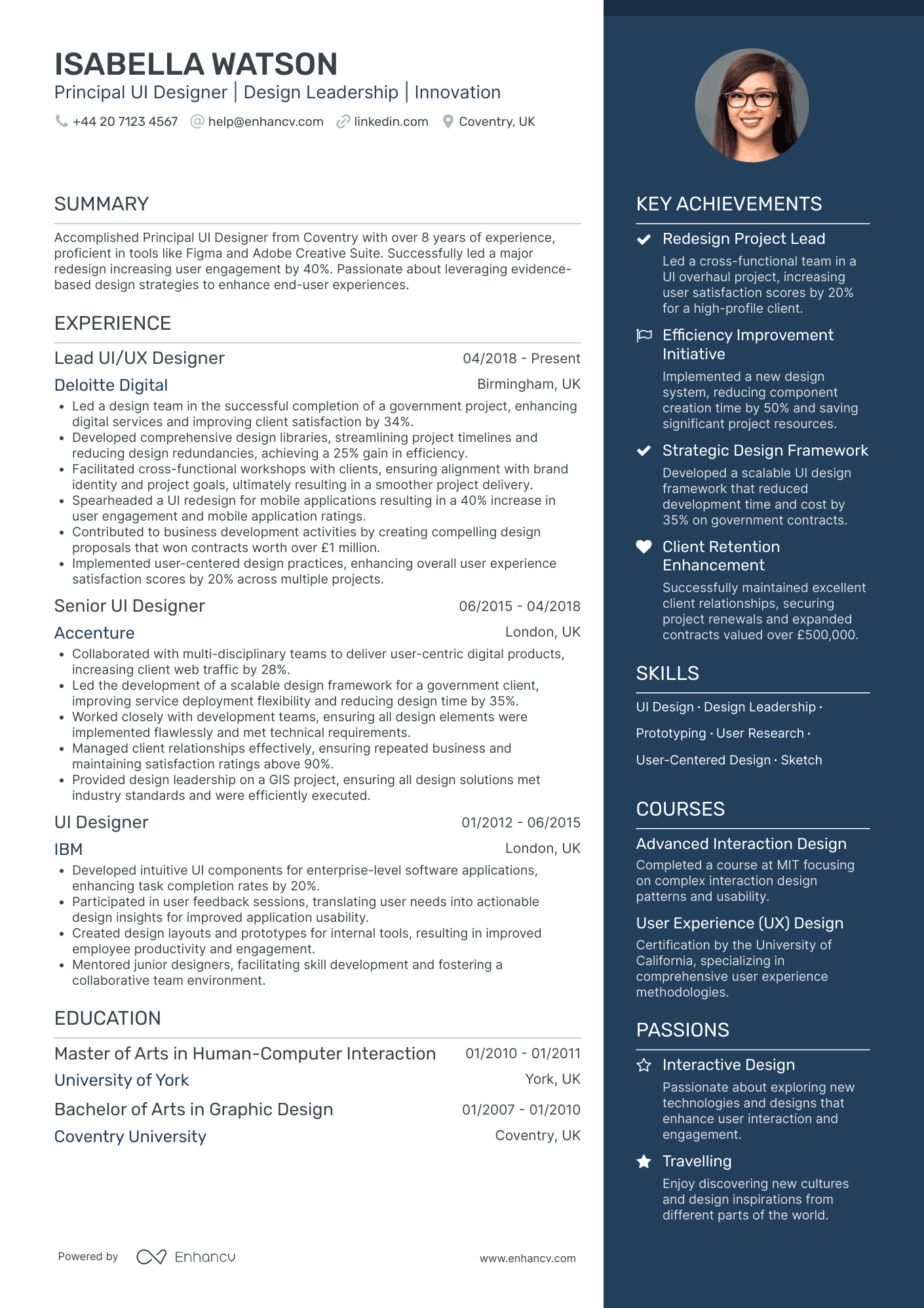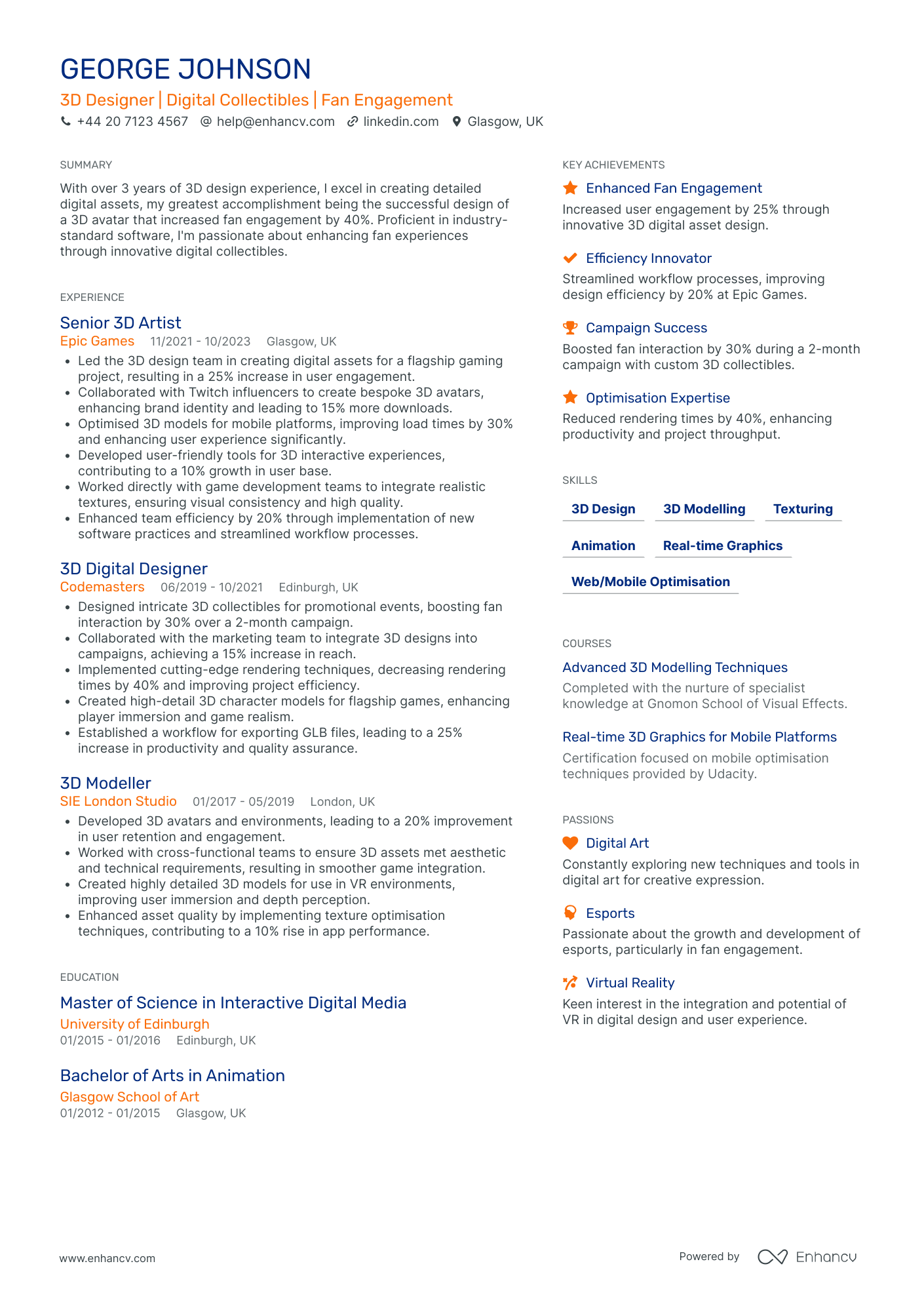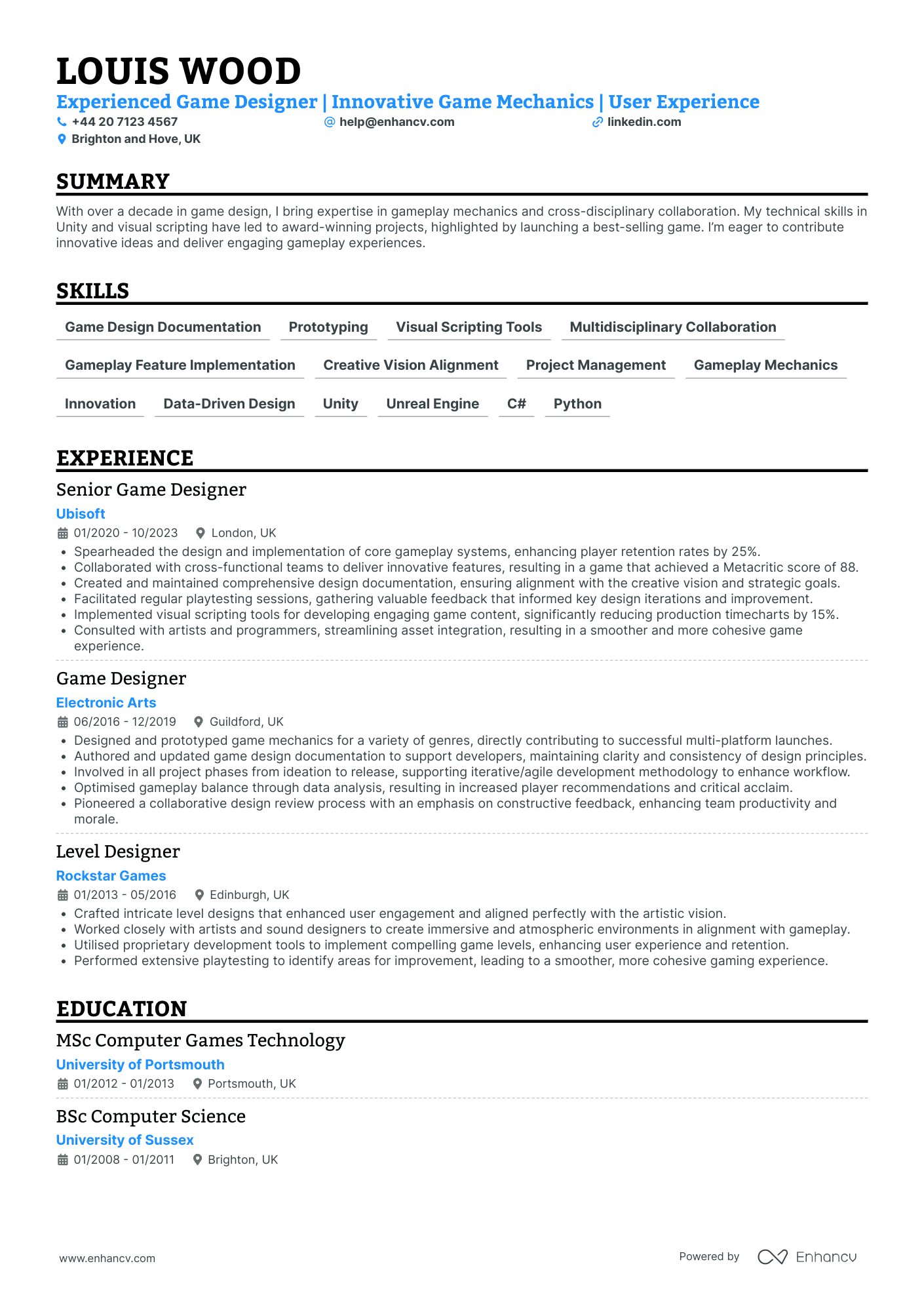Ensuring your CV stands out to potential employers is a significant challenge in the competitive field of design. Our guide offers expert tips and industry-specific strategies to help you craft a CV that showcases your unique creative talents and grabs attention.
- Answer job requirements with your designer CV and experience;
- Curate your academic background and certificates, following industry-leading CV examples;
- Select from +10 niche skills to match the ideal candidate profile
- Write a more succinct experience section that consists of all the right details.
Do you need more specific insights into writing your designer CV? Our guides focus on unique insights for each individual role:
CV examples for designer
By Experience
Senior Interior Designer
- Effective Content Structuring - The CV is excellently structured, beginning with a personal summary that immediately captures attention. Each section is clearly delineated, from personal details through to professional experiences and education, ensuring the information flows logically and is easy to navigate. The use of bullet points for detailing responsibilities and accomplishments ensures that key points are quickly absorbed by the reader.
- Impressive Career Progression - The career trajectory depicted in the CV showcases a pattern of consistent upward mobility. Starting at a junior level position in software development, the individual has progressed to senior roles, demonstrating not only a deepening of expertise but also the trust placed in them by employers to take on more significant responsibilities. Each role change marks a clear growth in skills and leadership capabilities, reflecting a proactive approach to career advancement.
- Deep Technical Expertise - This CV highlights unique industry-specific skills that stand out within the field of data analytics. The candidate has proficiency in advanced tools and methodologies like R, Python, and machine learning frameworks which are specified in various projects. Their technical depth is further evidenced by the mention of leading cross-functional teams to implement data-driven solutions that resulted in improved business metrics.
Junior Web Designer
- Optimized Content Presentation - The CV utilizes a clear and logical structure that enhances readability, with well-organized sections and concise bullet points that outline key responsibilities and achievements. This approach ensures that hiring managers can swiftly assess the candidate’s suitability for the role without wading through unnecessary detail.
- Impressive Career Trajectory - The career progression detailed within the CV is notable, reflecting both vertical growth with promotions to leadership roles and horizontal movements across industries that expand the candidate’s expertise. This trajectory suggests a professional who not only elevates their own skills but also adapts and thrives in diverse working environments.
- Proficiency in Niche Industry Tools - Unique to this CV is the demonstrated proficiency in specialized industry tools and methodologies, such as advanced data analytics software and machine learning applications. This technical depth positions the candidate as highly competent in their field, highlighting a commitment to staying at the forefront of industry advancements.
Lead Designer
- Clear and Structured Content Presentation - The CV exhibits a well-organized structure with clearly defined sections. It uses concise bullet points to present achievements and responsibilities, ensuring that key information is easily accessible and digestible for potential employers.
- Impressive Career Trajectory in Luxury Automotive Industry - Sophia Brooks' career showcases a progressive trajectory, advancing from a Brand Designer at Bentley Motors to a Lead Designer at Aston Martin. This growth reflects her capability to take on increasing responsibilities and her strong reputation within the luxury design industry.
- Proficiency in Industry-Specific Design Tools and Techniques - The CV emphasizes a strong command of technical tools such as Adobe Creative Suite and 3D Modelling Software. This technical depth, combined with methodologies like brand identity strategy and modern luxury design principles, underscores her expertise and relevance in her field.
Assistant Designer
- Career Development and Industry Progression - The CV effectively outlines a progressive career path, with significant roles in prestigious financial institutions such as Goldman Sachs, Barclays, and J.P. Morgan. It highlights the candidate's upward mobility and ability to thrive in high-pressure environments, from a Production Designer to a Design Specialist role, underscoring their growing responsibilities and leadership skills within the financial sector.
- Diverse Skill Set and Technical Expertise - The CV showcases Freddie Hughes' extensive proficiency with industry-specific tools and methodologies, particularly within Adobe Suite and Financial Data Analysis. This technical depth is complemented by a strategic application of skills in creating impactful visual assets that translate complex data into accessible formats, showcasing their innovative approach and competency in key software vital to the role.
- Cross-functional Collaboration and Leadership - Highlighted throughout the CV is the candidate's engagement with cross-functional teams, which illustrates their collaborative spirit and leadership abilities. By managing projects across departments and leading initiatives such as conference material redesign and education workshops, Freddie demonstrates adaptability and an ability to work harmoniously across various segments of an organization to achieve strategic goals.
By Role
Graphic Designer
- Clear Professional Summary - The CV begins with a concise and well-articulated professional summary, clearly communicating the candidate's expertise in graphic design, brand identity, and creative concepts. It effectively outlines their eight years of experience and track record in enhancing customer engagement, setting the stage for a capable and results-driven designer.
- Impressive Career Growth - The career trajectory from Junior Graphic Designer to Senior Graphic Designer reflects a clear path of growth and progression. Each role demonstrates increasing responsibility and impact, highlighting the candidate's ability to advance within their field and assume leadership roles in reputable companies.
- Proven Impact through Achievements - The CV contains measurable achievements, such as enhancing digital campaign engagement by 40% and reducing project delivery times by 20%. These metrics are not merely numbers; they illustrate a significant impact on business outcomes, showcasing the candidate’s ability to deliver value and drive growth.
Fashion Designer
- Structured Career Progression - Ava Phillips' career trajectory is marked by steady growth in the fashion industry, advancing from an Apparel Production Specialist at Marks & Spencer to a Garment Technician at ASOS. This progression underscores a continuous expansion of responsibilities and a demonstrated capability to thrive in increasingly complex roles.
- Technical Proficiency and Innovation - The CV highlights Ava’s deep technical expertise in tools like CAD software for pattern making, which enabled a 40% faster turnaround time in pattern creation. Her innovative methods led to significant efficiency improvements, such as reducing production costs by 15% through pattern redesigns and optimization.
- Proven Impact Through Achievements - Throughout her experience, Ava's achievements are tied to clear business impacts. Her efforts not only improved efficiency and reduced costs but also resulted in increased sales and market share, showcasing the tangible benefits of her strategies.
Industrial Designer
- Clear Structure and Concise Presentation - The CV uses a straightforward and organized format, making it easy to navigate through different sections. The use of bullet points for each job role ensures conciseness and clarity, allowing key achievements and responsibilities to stand out effortlessly.
- Progressive Career Trajectory - Charlotte's career path demonstrates significant growth, transitioning from a Product Design Engineer at Ikea to a Senior Industrial Designer at Dyson. This highlights not only her ability to adapt but also her continual pursuit of advancing her skills and responsibilities within the industry.
- Use of Industry-Specific Tools and Methods - The CV showcases Charlotte's proficiency in critical design and prototyping tools like Solidworks, Adobe Creative Suite, and KeyShot. This technical depth is further enhanced by industry-specific courses completed to advance her modeling and manufacturing knowledge.
UX Designer
- Clarity and Conciseness in Presentation - The CV is well-structured, allowing for easy navigation through James Lewis's career history, education, skills, and achievements. Information is presented in a concise manner which aids clarity, ensuring that key details about his capabilities and experiences are not lost in excessive detail.
- Progressive Career Trajectory - The progression from UI/UX Designer to Senior UX Designer demonstrates a clear upward career trajectory. James has rapidly advanced within renowned companies in the field like Skyscanner and FanDuel, gaining substantial responsibility and leadership roles over the years, highlighting his growth and adaptability within the industry.
- Implementation of Design Best Practices - James has an impressive grasp of industry-standard tools and methodologies such as Adobe Creative Suite, Sketch, and Figma. His focused approach to user research and prototyping highlights a strong technical foundation, which is enhanced by his commitment to design thinking and thorough usability testing practices.
UI Designer
- Comprehensive Career Growth - Isabella Watson's career trajectory displays a well-defined path of growth from a UI Designer at IBM to a Principal UI Designer at Deloitte Digital, highlighting her expertise and leadership advancement within the design domain.
- Robust Soft Skills and Leadership Abilities - Throughout her roles, Isabella has demonstrated strong leadership and collaborative skills, managing design teams, conducting workshops, and maintaining high client satisfaction scores, which are crucial for a Principal UI Designer.
- Impactful Achievements with Business Relevance - The CV impressively showcases achievements that have significant business impact, such as spearheading a UI redesign that increased user engagement by 40% and creating design proposals that led to securing contracts worth over £1 million.
Product Designer
- Clear and Compelling Content Presentation - The CV is structured logically, starting with a concise summary that encapsulates the candidate’s key strengths. The experience section is detailed yet succinct, providing clear outcomes for each role. This clarity not only highlights achievements but also makes the document easy to navigate.
- Strategic Career Progression - Matilda demonstrates a clear growth trajectory from Junior Product Designer to Senior Product Designer within six years, showcasing an ability to not only learn rapidly but to take on increased responsibility. This progression within the SaaS and EdTech industries shows loyalty and depth of industry experience that is invaluable.
- Emphasis on Leadership and Mentorship - Beyond her technical skills, Matilda’s CV highlights her role in mentoring junior designers, fostering a learning culture within her team. This indicates strong leadership capabilities, essential for senior roles and for driving team success.
Motion Graphics Designer
- Concise and Structured Layout - The CV shines with a clear and well-organized presentation, where each section is clearly demarcated. This structure supports ease of navigation and allows a quick overview of the candidate’s qualifications, making it simple for recruiters to find relevant information.
- Progressive Career Development - The career trajectory reflected in this CV highlights a strong pattern of growth and upward mobility within the industry. The candidate has consistently advanced from junior to senior roles, showing adaptability and a commitment to professional development, which is critical for this role.
- Industry-Specific Tools Expertise - The CV impressively details the candidate's proficiency with specific tools and methodologies, such as Agile project management and specific software systems pertinent to their field. This indicates a deep technical understanding and capability to leverage these tools to career advantage.
Jewellery Designer
- Cohesive Structure and Clear Presentation - The CV is well-organized, beginning with a concise summary that encapsulates Evie's career, setting the stage for the detailed sections that follow. Each section is clearly delineated, with bullet points efficiently communicating key responsibilities and achievements, making it easy to navigate and understand the candidate’s qualifications.
- Progressive Career Trajectory - Evie has demonstrated significant career growth, advancing from a Jewelry Designer to a Lead Jewelry Designer within renowned companies like Clogau Gold, Pandora, and Swarovski. This progression highlights her capability to take on increased responsibilities and leadership roles, signifying her ambition and value to potential employers.
- Technical Prowess in Jewelry Design - The CV underscores Evie’s command of industry-specific tools and methodologies such as CAD, Illustrator, and Photoshop, which are critical for modern jewelry design. Her expertise in these areas not only supports her design capabilities but also contributes to process improvements and innovative product development.
Landscape Designer
- Distinctive Content Presentation - The CV is structured clearly with distinct sections that outline Joshua's professional journey, from education to achievements. Bullet points under each role provide concise descriptions of responsibilities and contributions, enabling easy navigation and ensuring clarity throughout.
- Impressive Career Trajectory - Joshua's career path demonstrates significant growth, from a Junior Landscape Designer to a Lead Landscape Designer, reflecting steady advancement and increasing responsibilities. This progression illustrates his capability and readiness for leadership roles within the landscape design industry.
- Innovative Industry Tools and Practices - Joshua's use of industry-specific tools like AutoCAD, Adobe Creative Suite, and Real Time Landscape Architect is highlighted, showcasing his technical depth. Furthermore, his integration of eco-friendly practices into designs demonstrates a commitment to sustainability, a crucial aspect of modern landscape architecture.
Textile Designer
- Structured Presentation with Conciseness - Theodore Green's CV is well-organized, making it easy for readers to follow his professional journey. It employs clear headings and concise bullet points under each section, allowing for quick absorption of the important information. The structure aids in highlighting his contributions to each role without overwhelming the reader with excessive details.
- Career Advancement and Strategic Roles - Theodore has shown a clear career trajectory with advancements from a Junior Textile Designer to a Senior Textile Designer. His roles at different esteemed companies like Liberty Fabrics, Johnstons of Elgin, and Turini Textiles present a pattern of growth and an increasing level of responsibility, reflecting his capability to handle more strategic tasks as he progressed in his career.
- Unique Expertise in Sustainable Textiles and Industry Tools - His proficiency with the Shima Apex 4 and his focus on sustainable fabric design set him apart in the industry. He leverages these skills to innovate and improve design processes, contributing significant eco-friendly advancements in textile production. Theodore's commitment to sustainability is also emphasized through his coursework and industry achievements.
Automotive Designer
- Structured Career Progression - Lucas Adams' CV demonstrates a logical and impressive career trajectory from a 3D Modelling Specialist at McLaren Automotive to a Creative Designer at Jaguar Land Rover. This progression indicates growing responsibilities and expertise in automotive design, emphasizing his evolving industry acumen and leadership potential.
- Technical Proficiency and Industry Tools - The CV showcases Lucas' proficiency with industry-specific tools and methodologies like 3D Modelling, Adobe Creative Suite, AutoCAD, and trend analysis. These skills are critical in automotive design, emphasizing his technical depth and ability to leverage advanced tools for innovative design solutions.
- Impactful Achievements with Business Relevance - The CV effectively highlights achievements that not only list quantitative metrics but also underline their business impact. For instance, leading projects that boosted design ergonomics by 25% and customer satisfaction by 30% showcases Lucas' ability to drive strategic improvements that directly benefit the company's market position and client engagement.
3D Designer
- Career Trajectory Demonstrates Growth and Adaptability - George Johnson's CV showcases a progressive career path with increasing responsibilities, highlighting transitions from a 3D Modeller to a Senior 3D Artist role at leading companies such as Epic Games and Codemasters. This progression underscores his ability to adapt and grow within the dynamic gaming industry, enhancing both user engagement and efficiency.
- Emphasis on Industry-Specific Tools and Methodologies - The document outlines George's proficiency in industry-standard software like Maya, ZBrush, Adobe Suite, Unity, and Unreal Engine, demonstrating a robust technical foundation. His specialized knowledge in GLB file creation and real-time graphics for web and mobile platforms positions him as an expert in optimizing digital assets for diverse use cases.
- Achievements Highlight Tangible Business Impacts - The CV effectively communicates the measurable business impacts of George's work. For instance, he contributed to a 25% increase in user engagement through leading 3D design for a flagship gaming project and optimized 3D models to improve mobile load times by 30%, reflecting his strategic contribution to operational efficiencies and user satisfaction.
Digital Designer
- Structured Presentation of Experience and Skills - The CV is meticulously organized, presenting each section with clarity and structure. It makes effective use of bullet points to succinctly convey Sophia Foster's professional journey, providing easily digestible insights into her capabilities and achievements. This organization ensures that key information, like her proficiency in Adobe Suite and success in enhancing campaign outputs, is readily accessible.
- Career Growth in Digital Design - Sophia Foster’s career progression from a Junior Graphic Designer to a Senior Digital Designer demonstrates a clear trajectory of growth, marked by promotions and increased responsibilities. Her advancement within the digital campaign design sector, alongside shifts to increasingly high-profile companies, underscores her ability to adapt and excel in dynamic environments. This growth is indicative of her leadership qualities and expertise in the field.
- Proficiency in Specialized Tools and Methodologies - The CV highlights Sophia's deep technical proficiency with industry-specific tools such as Adobe Creative Suite and Celtra. Her background is rich with experience in crafting interactive advertisements, utilizing motion graphics, and implementing A/B testing strategies. These elements showcase her technical depth and illustrate her capability to leverage specialized tools to optimize campaign performance and drive client satisfaction.
Game Designer
- Comprehensive and Well-Structured Content Presentation - The CV stands out with its clear, structured format, effectively highlighting key accomplishments and expertise through concise bullet points. This structured approach ensures quick comprehension for recruiters, allowing them to easily identify significant achievements and skill sets pertinent to game design and user experience.
- Diverse and Progressive Career Trajectory - Louis Wood's career showcases impressive growth and adaptability, transitioning from a level designer at Rockstar Games to a senior game designer at Ubisoft. This progression reflects a trajectory of increasing responsibility and expertise within the gaming industry, emphasizing his ability to thrive and innovate in varied environments.
- Integration of Cutting-Edge Tools and Methodologies - The CV highlights the use of high-level tools and methodologies, such as visual scripting tools and proprietary development software, underscoring Louis's technical proficiency. Such specific mentions prove his capability to leverage industry-specific technologies, ensuring high-quality game development and optimizing production timelines effectively.
Furniture Designer
- Structured and cohesive presentation - This CV is well-organized, with each section clearly delineated and easy to navigate. The use of bullet points in the experience section aids in quickly conveying the impact of the candidate's contributions. Summary, experience, education, skills, courses, achievements, languages, and passions are all logically ordered and concisely written, presenting a comprehensive picture of the candidate's professional journey.
- Clear career progression - The career trajectory shows a logical progression from a Junior Designer to a Senior Product Designer, with increasing responsibilities and leadership roles over the years. This progression demonstrates a commitment to growth within the product design field, moving from hands-on design tasks to leading teams and driving strategic initiatives at a senior level.
- Industry-specific expertise - The CV highlights specific tools and methodologies relevant to product design, such as CAD Modelling, SolidWorks, and Photoshop. The candidate's experience with technical drawing and manufacturing processes indicates a deep technical understanding, which is crucial for the role of a Senior Product Designer. This technical depth is complemented by achievements in design innovation and cost reduction, showcasing a balanced skill set.
Packaging Designer
- Clarity and Structured Presentation - Grace Bailey's CV excels in providing a clear and well-organized presentation. The use of concise bullet points and logical headings ensures easy readability and allows hiring managers to quickly identify relevant information. Her contact details, summary, and sections like experience, education, skills, and achievements are neatly formatted, highlighting her qualifications and career progression comprehensively.
- Demonstrated Career Growth - Her career trajectory reveals significant growth and industry relevance, having moved from a Graphic Designer at Mondi Group to key roles in product design and packaging engineering at renowned companies such as DS Smith and Smurfit Kappa. With each step, there is a clear progression in responsibilities and impact, showcasing her as a seasoned professional in sustainable packaging and product design.
- Innovative and Collaborative Achievements - Grace's accomplishments encompass innovative initiatives and collaboration across departments, with achievements that translate to substantial business outcomes. For instance, her leadership in sustainable packaging innovations at DS Smith increased recycled material usage by 25% and improved client retention by 20%, demonstrating her ability to deliver not just on creative fronts but also in driving business growth and sustainability.
Structuring your designer CV layout: four factors to keep in mind
There are plenty of best practices out there for your CV layout and design. At the end of the day, a clear format and concise CV message should be your top priority. Use your CV design to enhance separate sections, bringing them to the forefront of recruiters' attention. At the same time, you can write content that:
- Follows the reverse chronological order in the experience section by first listing your most recent jobs;
- Incorporates your contact information in the header, but do skip out on the CV photo for roles in the UK;
- Is spotlighted in the most important sections of your CV, e.g. the summary or objective, experience, education, etc. to show just how you meet the job requirements;
- Is no longer than two-pages. Often, the one-page format can be optimal for your designer CV.
Before submitting your CV, you may wonder whether to export it in Doc or PDF. With the PDF format, your information and layout stay intact. This is quite useful when your CV is assessed by the Applicant Tracker System (or the ATS) . The ATS is a software that scans your profile for all relevant information and can easily understand latest study on the ATS , which looks at your CV columns, design, and so much more.
PRO TIP
Be mindful of white space; too much can make the CV look sparse, too little can make it look cluttered. Strive for a balance that makes the document easy on the eyes.
The top sections on a designer CV
- Personal statement offers a quick insight into your design philosophy.
- Design portfolio showcases your best work and style.
- Work experience details past roles and relevant projects.
- Education background includes degrees and design-related courses.
- Technical skills highlight software proficiency and design tools.
What recruiters value on your CV:
- Highlight your design portfolio by including a link to your online portfolio or attaching visual examples of your work to demonstrate your range of skills and aesthetic sensibility.
- Showcase your proficiency in design tools and software, such as Adobe Creative Suite, Sketch, or Figma, to prove your technical capabilities and industry-relevant skills.
- Emphasise your understanding of design principles and processes by detailing your experience with user-centred design, typography, colour theory, and branding in your project descriptions.
- Include any collaboration or leadership experience to illustrate your ability to work in a team environment, manage projects, and communicate effectively with clients and colleagues.
- Mention any relevant awards, recognitions or publications to establish credibility and to signal to potential employers that your work is respected within the design community.
Recommended reads:
What information should you include in your designer CV header?
The CV header is potentially the section that recruiters would refer to the most, as it should include your:
- Contact details - your professional (non-work) email address and phone number;
- Professional photograph - if you're applying hinting at the value you bring as a professional.
Many professionals often struggle with writing their designer CV headline. That's why in the next section of this guide, we've curated examples of how you can optimise this space to pass any form of assessment.
Examples of good CV headlines for designer:
- Lead UX/UI Designer | Human-Centred Solutions | Adobe XD Specialist | 10+ Years in Digital Design
- Junior Graphic Designer | Bold Branding & Visual Identity | BA (Hons) Graphic Design | Emerging Talent
- Senior Interior Designer | Luxury Residential Spaces | CAD Expertise | 15 Years of Creative Excellence
- Creative Director | Multidisciplinary Design Leadership | Brand Strategy | MA Design Innovation | 20+ Years
- Digital Fashion Illustrator | Trend-Setting Apparel Art | Advanced Photoshop | 5 Years Industry Impact
- Product Designer | User Experience Architect | Prototyping Guru | BSc Industrial Design | 8 Years' Innovation
Catching recruiters' attention with your designer CV summary or objective
Located closer to the top of your CV, both the summary and objective are no more than five sentences long and serve as an introduction to your experience. What is more, you could use either to entice recruiters to read on. Select the:
- Summary, if you happen to have plenty of relevant experience. Feature your most impressive accomplishments and up to three skills that are relevant to the job you're applying for;
- Objective, if you're just starting your career off. Provide your career goals and answer how you see the role you are applying for will match your professional growth.
Judging which one you need to add to your designer CV may at times seem difficult. That’s why you need to check out how professionals, with similar to your experience, have written their summary or objective, in the examples below:
CV summaries for a designer job:
- With over 10 years of experience in graphic design, specialising in brand identity and digital illustration, I've successfully led a rebranding campaign for a major tech firm, increasing their market visibility by 45%. Skilled in Adobe Creative Suite, I bring a proven track record of creative innovation and a strong aesthetic sense.
- As an accomplished UX/UI designer boasting 8 years of experience, I take pride in having forged intuitive interfaces for SaaS products, which led to a 30% increase in user engagement. My expertise lies in user-centric design principles, wireframing, and prototyping using Sketch and InVision.
- Transitioning from a successful 7-year career in architecture to graphic design, I bring a unique perspective that combines spatial awareness with visual composition. Fluent in AutoCAD and Adobe Creative Suite, I am eager to apply my design sensibilities within a new medium and contribute fresh visual solutions.
- Formerly a professional photographer with a keen eye for aesthetics, I am making the leap into graphic design. With a 5-year journey of capturing stories through the lens, I'm excited to transition these narrative skills into creating compelling visual designs using my proficiency in Photoshop and InDesign.
- Seeking to utilise a passion for digital art and a fresh perspective to embark on a new path in UX/UI design. While my background is not traditional, my dedication to learning and applying design principles, coupled with a deep interest in user-centric technology, drives me to excel in this field.
- Eager to unleash my potential as a junior graphic designer and grow within a dynamic team, my objective is to contribute innovative ideas and designs. My proficiency in Illustrator and commitment to continuous learning, backed by expertise in social media content creation, will fuel my journey in the creative industry.
Best practices for writing your designer CV experience section
If your profile matches the job requirements, the CV experience is the section which recruiters will spend the most time studying. Within your experience bullets, include not merely your career history, but, rather, your skills and outcomes from each individual role. Your best experience section should promote your profile by:
- including specific details and hard numbers as proof of your past success;
- listing your experience in the functional-based or hybrid format (by focusing on the skills), if you happen to have less professional, relevant expertise;
- showcasing your growth by organising your roles, starting with the latest and (hopefully) most senior one;
- staring off each experience bullet with a verb, following up with skills that match the job description, and the outcomes of your responsibility.
Add keywords from the job advert in your experience section, like the professional CV examples:
Best practices for your CV's work experience section
- Quantify your design achievements with metrics, such as increasing user engagement by 20% after redesigning a web interface. Provide specific numbers to give credibility to your design impact.
- Highlight your proficiency in design software and tools, like Adobe Creative Suite or Sketch, by mentioning complex projects where these were essential. Demonstrate your versatility and expertise through examples.
- Include collaborative projects to showcase your teamwork abilities, stating how you communicated and worked with cross-functional teams to achieve design goals. Emphasise your role within these collaborations.
- Discuss your experience with user-centred design by listing projects where you conducted user research, created personas, and designed with usability in mind. Show your commitment to creating user-friendly designs.
- Detail your creative process by explaining your approach to problem-solving, from conceptualisation to the final design. Share how your creative thinking led to successful outcomes.
- Describe your experience with brand development and how you have contributed to establishing or evolving a company's visual identity. Mention specific brand elements you created or improved.
- Mention any leadership experience, such as leading a design team or project, detailing your role in guiding design direction and mentoring junior designers. Highlight your ability to manage and inspire.
- Outline your experience with responsive design by discussing projects where you created designs that adapt to various devices and screen sizes. Detail the challenges and your effective solutions.
- Cite any awards or recognitions you have received for your design work, which can help to reinforce your expertise and reputation in the industry. Explain the significance of these accolades.
- Led design initiatives for flagship products, achieving a user satisfaction score increase of 25% year-over-year
- Managed a cross-functional team of 5 designers and developers to overhaul the product design language, successfully launching the new design within 10 months
- Collaborated closely with engineering and marketing teams to integrate user research into product features, contributing to a 40% reduction in churn rate
- Designed and delivered a comprehensive UX strategy for SaaS platforms, improving client onboarding time by 30%
- Instrumental in user testing and feedback loops, refining user personas and journey maps to better match customer needs
- Oversaw the implementation of A/B testing protocols that led to a 20% improvement in conversion rates
- Conceptualized and implemented a responsive design framework for web applications, enhancing the user experience across various devices and platforms
- Collaborated with product management to develop user-centric designs, resulting in a 15% increase in user engagement
- Developed wireframes, prototypes, and high-fidelity visuals for more than 20 major projects, aligning with brand standards and business goals
- Created and maintained the visual identity for over 50 corporate clients, effectively communicating brand values and messages
- Steered the creative direction for major marketing campaigns, which saw increases in consumer engagement by up to 35%
- Mastered various design software and tools, streamlining production times by 20% while maintaining high-quality outputs
- Researched and applied interactive elements to digital platforms that improved user task completion rates by 40%
- Facilitated workshops and interactive prototyping sessions to gather real-time user feedback, informing iterative design improvements
- Piloted a new framework for gathering and analyzing user interaction data, which became a standard process in the design team
- Expanded clientele by 150% through networking and high-quality deliverables within the span of 1 year
- Implemented innovative design solutions for various media, including print, web, and mobile applications
- Effectively managed multiple projects simultaneously, with an average project rating of 4.8/5.0 from clients
- Supported design team in delivering creative work within tight deadlines, recognized with a team excellence award for Q4 2010
- Assisted in the development of branding materials, resulting in a consistent visual language for 3 new product launches
- Contributed to user interface design improvements, contributing to a 10% uplift in user experience scores
What to add in your designer CV experience section with no professional experience
If you don't have the standard nine-to-five professional experience, yet are still keen on applying for the job, here's what you can do:
- List any internships, part-time roles, volunteer experience, or basically any work you've done that meets the job requirements and is in the same industry;
- Showcase any project you've done in your free time (even if you completed them with family and friends) that will hint at your experience and skill set;
- Replace the standard, CV experience section with a strengths or achievements one. This will help you spotlight your transferrable skills that apply to the role.
Recommended reads:
PRO TIP
Describe how each job helped you grow or learn something new, showing a continuous development path in your career.
Key designer CV skills: what are hard skills and soft skills
Let's kick off with the basics. You know that you have to include key job requirements or skills across your CV. For starters, take individual skills from the job description and copy-paste them into your CV, when relevant. Doing so, you'll ensure you have the correct skill spelling and also pass the Applicant Tracker System (ATS) assessment. There are two types of skills you'll need to include on your CV:
- Hard skills - technical abilities that are best defined by your certificates, education, and experience. You could also use the dedicated skills section to list between ten and twelve technologies you're apt at using that match the job requirements.
- Soft skills - your personal traits and interpersonal communication skills that are a bit harder to quantify. Use various CV sections, e.g. summary, strengths, experience, to shine a spotlight on your workspace achievements, thanks to using particular soft skills.
Remember that your job-winning CV should balance both your hard and soft skills to prove your technical background, while spotlighting your personality.
Top skills for your designer CV:
Adobe Creative Suite
Sketching & Wireframing
UI/UX Design
Typography
Graphic Design
Web Design
Branding
3D Modelling
Animation
HTML/CSS
Creativity
Attention to Detail
Problem-Solving
Time Management
Communication
Teamwork
Critical Thinking
Adaptability
Project Management
Empathy
PRO TIP
Focus on describing skills in the context of the outcomes they’ve helped you achieve, linking them directly to tangible results or successes in your career.
Further professional qualifications for your designer CV: education and certificates
As you're nearing the end of your designer CV, you may wonder what else will be relevant to the role. Recruiters are keen on understanding your academic background, as it teaches you an array of hard and soft skills. Create a dedicated education section that lists your:
- applicable higher education diplomas or ones that are at a postgraduate level;
- diploma, followed up with your higher education institution and start-graduation dates;
- extracurricular activities and honours, only if you deem that recruiters will find them impressive.
Follow a similar logic when presenting your certificates. Always select ones that will support your niche expertise and hint at what it's like to work with you. Balance both technical certification with soft skills courses to answer job requirements and company values. Wondering what the most sought out certificates are for the industry? Look no further:
PRO TIP
Use mini case studies or success stories in your CV to demonstrate how your skills have positively impacted previous roles or projects.
Recommended reads:
Key takeaways
Here are five things you need to remember about writing your designer CV for success:
- Sort your experience based on the reverse chronological order, starting with your most recent career items, to showcase how you've grown your career;
- Include within your CV header your relevant contact details, a headline that could spotlight your unique value, and a photo - if you're applying for roles outside the UK or US;
- Decide to use the CV summary, if you happen to have more professional experience, and an objective, if you want to showcase your career goals;
- Within the experience section, write your bullets using action verbs, skills, and success, instead of just merely listing your on-the-job responsibilities;
- Prove your technical skills, using your education and certificates, and your soft skills, with your achievements and strengths sections.
